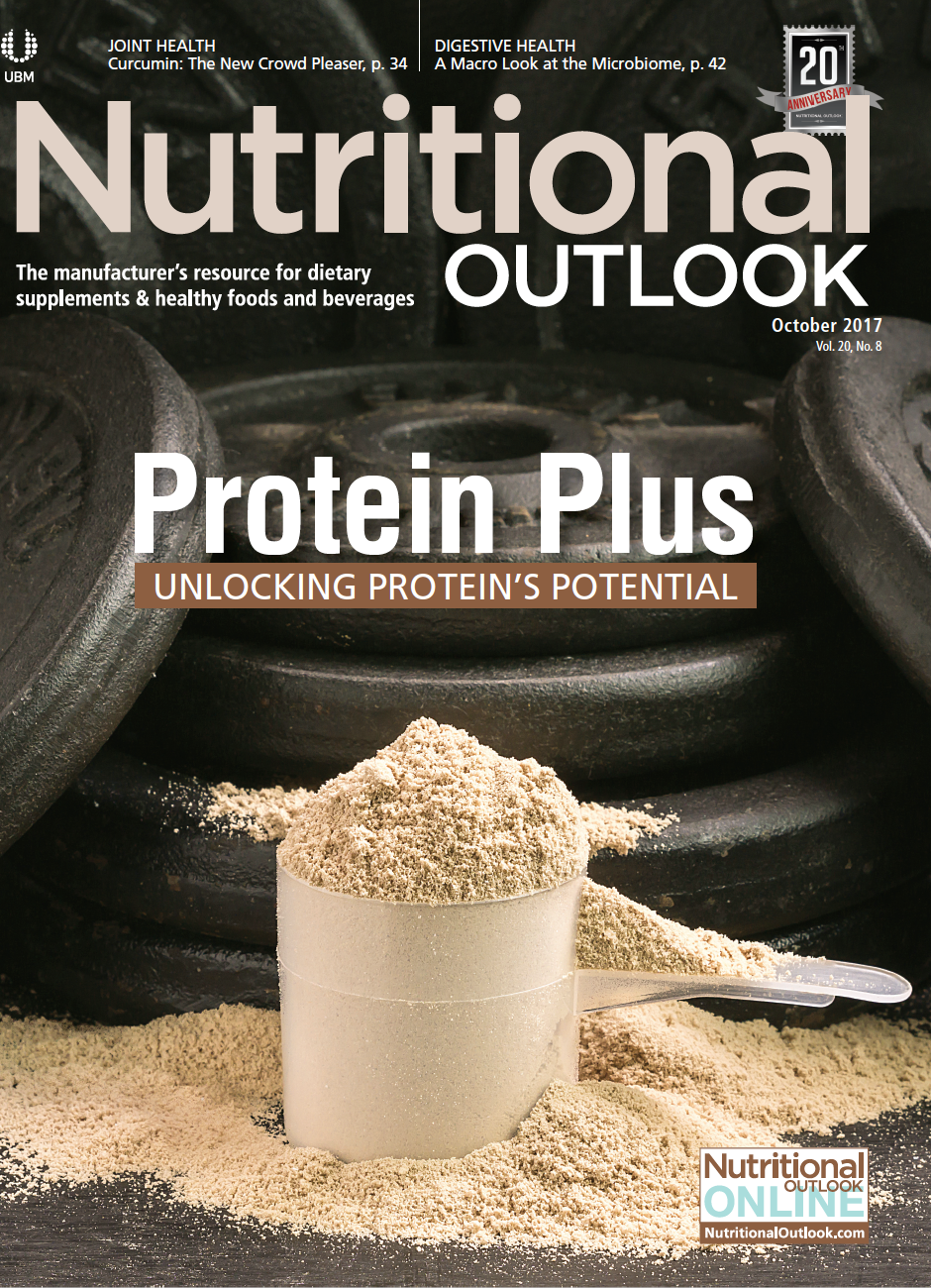Curcumin’s Growing Popularity in Joint-Health Dietary Supplements
Curcumin’s joint-health benefits appeal across the board.
Photo © Shutterstock.com/Fecundap stock

According to the Centers for Disease Control and Prevention, an estimated 54.4 million Americans-that’s 22.7% of the adult population-have been told they have some form of arthritis, rheumatoid arthritis, gout, lupus, or fibromyalgia. By 2040, the agency estimates that 26% of adults aged 18 or older will have doctor-diagnosed arthritis.
This, on its own, represents a clear opportunity for supplements, as consumer preferences shift to natural remedies overall. But if you ask Alexis Manfre, global category manager of nutrition and health at Naturex (Avignon, France), even within the joint-health supplement market, trends are shifting from synthetic to natural solutions. Citing data from SPINS, Manfre explains that traditional category leaders like glucosamine and chondroitin, as well as hyaluronic acid, are experiencing sales declines. On the other hand, SPINS reports that sales of curcumin-based vitamins, dietary supplements, herbal products, and homeopathic products, for instance, are through the roof, growing 45.3% to reach $72 million last year alone.
Why? “Glucosamine, chondroitin, MSM, and various other joint-health products have been around for a long time,” says Deanne Dolnick, science director for TR Nutritionals (Alpharetta, GA). “Many consumers have tried these with varying levels of success. For those who are looking for something new, curcumin is a wonderful option. Those consumers who are just purchasing their first joint-health products want the hottest ingredient. Right now, that is curcumin.”
Manfre agrees, noting that the most important driver of this trend is that there exists a growing body of research to support curcumin’s benefits for joint health, spurring newfound excitement in this ayurvedic staple.
Research Strides
Curcumin’s effect on osteoarthritis remains an active area of research.
Just last year, Sabinsa’s (East Windsor, NJ) Curcumin C3 Complex was used in a randomized six-week trial examining the effects of curcumin on reducing systemic oxidative burden in patients suffering from knee osteoarthritis.1 Researchers recruited 40 patients with mild to moderate osteoarthritis, and administered either curcuminoid capsules (1500 mg/day over the course of three doses) or placebo. “The results showed improvement in the osteoarthritic index and also improvement in stiffness, pain, and mobility of the joints,” explains Shaheen Majeed, Sabinsa’s worldwide president. “It also showed that in the presence of curcuminoids, the oxidative stress was reduced significantly, with increases in serum levels of superoxide dismutase and glutathione, and concurrently there was a decrease in malondialdehyde concentration.” Majeed says this research validates the antioxidant benefits of curcumin for osteoarthritis and its symptoms.
Osteoarthritis of the knee was also the focus of research published last year in Inflammopharmacology, which examined curcumin’s effect on the condition’s inflammatory and oxidative stress biomarkers.2 Researchers recruited 160 patients with knee osteoarthritis, randomly assigning them to receive either curcumin or placebo for 120 days. They were assessed on day 0, day 60, and at the conclusion of the study. Each assessment included a visual analog scale (VAS) and Western Ontario and McMaster Universities Osteoarthritis index assessment (WOMAC). Blood samples were collected to assess changes in IL-1 as well as biomarkers of oxidative stress like reactive oxygen species and malondialdehyde.
Overall, significant improvement was observed in the patients taking curcumin, as compared to placebo. The curcumin group’s VAS and WOMAC scores both improved, as did their biomarkers. The researchers concluded that ongoing administration of curcumin could improve both the markers and symptoms of osteoarthritis.
If you ask Yoshihiko Sumi, director of the science group at Tokyo-based Theravalues Corp., studies like these, which highlight the anti-inflammatory benefits of curcumin, have the potential to rebrand the ingredient as not just a joint-health ingredient but also a longevity ingredient. “This enables a better quality of life among the aging society,” he says, citing the vast implications for brain, skin, and other areas. “These are all aging-related impairments, and curcumin will be able to prevent or slow down the progressions of them.”
Hand in hand with joint health is bone health, as the latter is needed to support the former. And perhaps nothing is so closely linked with aging as the loss of bone density. According to the International Osteoporosis Foundation, osteoporosis impacts one out of every 10 women over age 60 and the numbers only increase with age, ultimately impacting two-thirds of women by age 90. Worldwide, one out of every three women over age 50 will experience an osteoporotic fracture, as well one out of every five men over age 50.
New research coming out of Indena (Milan) recently linked curcumin with bone density maintenance.3 Researchers enrolled 57 healthy subjects with a bone mass condition, and randomized them into two different groups. During the six-month study period, the control group followed a standard management plan, while the supplement group supplemented their standard management plans with 1 g of Meriva, Indena’s proprietary curcumin ingredient. By the end of the study, at week 24, the Meriva group gained 7.1% and 4.8% increases in bone density of the small finger and upper jaw, respectively. No changes, however, were perceived in the control group.
But additional research is showing that curcumin’s benefits aren’t just for the aging; namely, curcumin’s joint-health benefits hold promise for athletes of any age. “New market opportunities within the 30-to-60-year age group are increasing, as these consumers want to maintain their active lifestyle without the associated aches and pains,” says Lynda Doyle, senior vice president of global marketing for OmniActive Health Technologies (Morristown, NJ). “These consumers are also trying to stem the onset of age-related joint conditions.”
To that end, the company’s curcumin ingredient, CurcuWin, is being put to the test with new research examining its ability to support joint health through the reduction of inflammatory pathways, namely lipoxygenase and cyclooxygenase enzymes. This research is awaiting publication, Doyle says. “Our ongoing clinical program continues to support the efficacy of CurcuWin, allowing for the nutritional benefits of turmeric in much smaller doses,” Doyle adds. “CurcuWin provides formulators of sports nutrition products support for a normal, healthy inflammatory response post-exercise, which may result in increased performance and recovery after exercise.”
Curcumin Delivers
When an ingredient transforms a category the way curcumin has, it’s only a matter of time until consumers want their supplements via creative deliveries. And if you ask Doyle, it’s undoubtable that delivery formats for curcumin have expanded. “Beverages, gels, powders, and gummies are increasingly popular delivery systems for the joint-health market,” she says. And, as Manfre points out, “we are now seeing turmeric used in a wide variety of applications depending on the targeted benefit, including beverages, shots, capsules, tablets, softgels, instant drinks, and protein bars.”
According to Majeed, one positive trend impacting the curcumin market is the migration of curcumin-based beverages out of Japan-where they’re a part of daily life-to other regions of the world. To meet demand for clear beverages without sediment, Sabinsa has developed uC3 Clear, a clear curcumin ingredient standardized for 10% curcuminoids that makes curcumin both visually appealing and soluble.
At Novel Ingredient Services (East Hanover, NJ), patent-pending Flavor-Balancing Technology allows formulators to incorporate ingredients-including but not limited to the company’s curcumin ingredient, Acumin-into functional foods and beverages without altering test, texture, or mouthfeel. Additionally, its patented Advanced Instantization Technology uses a proprietary particle-distribution technique that allows the incorporation of even the most texture-challenged powders, including Acumin. “Who knows,” muses CEO Rick Antonoff. “Acumin water or Acumin-enhanced Gatorade could be in our future!”
Also read:
Turmeric: Trend, or Here to Stay?
References:
- Panahi et al., “Mitigation of systemic oxidative stress by curcuminoids in osteoarthritis: results of a randomized controlled trial,” Journal of Dietary Supplements, vol. 13, no. 2 (2016): 209-220
- Srivastava S et al., “Curcuma longa extract reduces inflammatory and oxidative stress biomarkers in osteoarthritis of knee: a four-month, double-blind, randomized, placebo-controlled trial,” Inflammopharmacology, vol. 24, no. 6 (December 2016): 377-388
- Dugal M et al., “Effects of a curcumin-based supplementation in asymptomatic subjects with low bone density: a preliminary 24-week supplement study,” European Review for Medical and Pharmacological Sciences, vol. 21, no. 7 (April 2017): 1684-1689























